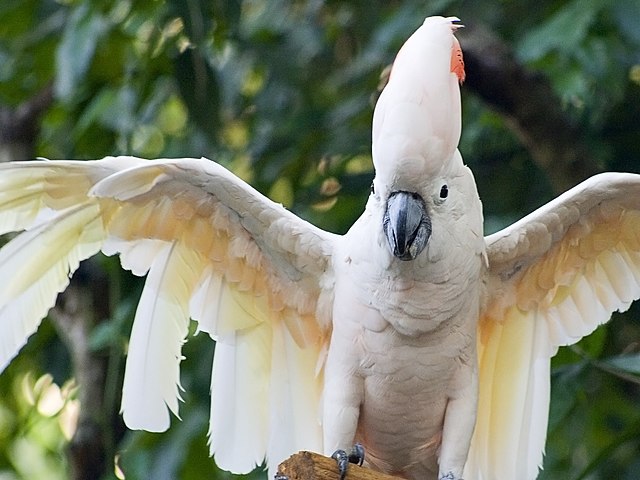If you are unsure how to properly clip your parrot’s wings, take the bird to an avian vet for its first clip. Let the vet explain to you how to clip the wings properly and show you as he clips your bird.
Let him also point out to you and make you careful of cutting blood feathers. When these are cut they bleed like an open vein. It is very dangerous.
Never leave outer primary flight feathers unclipped. Some people miss the first two or three feathers on the outside for appearance’s sake.
This is a bad idea for two reasons. One- it allows the bird to escape, even with the inner flights cut because it provides a certain amount of lift.
Two- with nothing to support these outer feathers, they will most certainly get damaged easily and break, leaving jagged edges which are very uncomfortable for your bird and will throw it off balance.
Never clip just one wing. your bird will be totally unbalanced and not be able to flutter in a straight line. This will make the birds panic and crash into things (including the floor) and injure themselves.
Each time your parrot needs to be re-clipped, the bird will have lost some strength in its wings and may not need so many feathers cut. Therefore you may wish to gradually reduce the number of feathers clipped (but never to zero feathers cut!).

Flying lessons with clipped wings
Start off by teaching your parrot to fly from A to B- just a short distance such as from your left arm to your right arm.
When the bird does this successfully reward it. Keep practicing this until the bird gets it right every time.
Then try flying a short distance from different spots, for example, a t-stand to your arm. As before, reward the bird when it gets this right.
Then try flying a short distance from your arm to the t-stand (or designated spot).
When you are happy that your bird is an accomplished lander, it is then appropriate to clip the wings.
It is quite important when giving flying lessons that you do not encourage your bird to fly long distances, as when the wings are clipped, your bird may attempt to fly as far as it could prior to clipping and injuring itself.
To clip or not to clip
It is not everyone’s belief that a domestic parrot should have its wings clipped. However, I believe that it is very important for the safety of our companion birds. A bird that can fly can fly into a glass or escape out of an open window or door. An escaped domestic bird will not last long fending for itself. It may be hit by moving traffic, killed by another animal, or starved.
A fate nobody wants for their beloved bird. Just today I read in the local newspaper a plea from a lady for people to be on the lookout for her pet Amazon of 37 years who escaped from his cage and out of the open window. And last week, whilst in the care of my grandma, my Grey escaped from his cage and went wandering up the garden. We live just off of a very busy road and had my bird not had clipped wings, I am sure he would not have survived. For this reason, I advise wing clipping very strongly.
A clipped bird should still be able to flutter a fair distance (about 10-15 feet perhaps) so that it is able to land safely if it falls from a height such as the top of its cage. It should also know how to land safely with clipped wings. In order for it to learn this, your bird will need to ‘fledge’. To do this, do not clip the bird’s wings straight away. you may wish to give your bird flying lessons yourself (a parrot does not automatically know how to fly).
